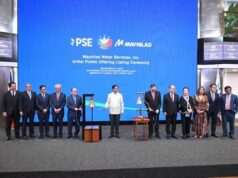New products signal Lenovo’s shifting focus away from PCs
By Mira Catherine B. Gloria, Online Managing Editor
LAS VEGAS — At this year’s Consumer Electronics Show (CES), Lenovo showed off its latest PC arsenal, including a powerful 2-in-1 notebook and its latest range of ThinkPad laptops, but the ones that drew the most attention were products that Lenovo was hardly known for — smart home and health care devices.
On the first day of CES 2018 held on Jan. 9, the PC titan unveiled a wireless virtual reality (VR) headset, a touchscreen display powered by Google, and a health-tracking modular device that can be attached to a Motorola phone.
Lenovo, which has a 21.1% share of the global PC market (next to HP’s 22.7%), said this is the beginning of its strategy shift as it seeks opportunities in other growth areas such as Internet of Things (IoT) and artificial intelligence (AI).
“Generally speaking, I think the PC market is stable. From a revenue point of view, it is getting better. [The market] is growing and it really helped our performance,” Lenovo Chairman and Chief Executive Officer Yuanqing Yang told reporters at The Venetian Hotel Las Vegas, hours after Lenovo unveiled its products. Mr. Yang was referring to the company’s 5% revenue growth (at $11.8 billion) in the quarter ending in September last year, driven largely by growth in its PC business.
The latest reports from market research firms Gartner and International Data Corp. (IDC) show the global PC market continues to shrink with shipments declining since 2012. Both firms also expect the decline of traditional PC shipments to continue as consumers move to other platforms and prefer ultra slim and convertible notebooks.
These indicators drive PC makers to rethink their strategy and re-evaluate their product mix. Two years ago, Dell refreshed its product line to cater to the millennial work force, which meant developing more stylish XPS notebooks with millennials in mind. HP, Inc., which last year edged Lenovo as the world’s top PC vendor, said it is gearing up for a 3D printer push.
For Lenovo, however, the future is in AI.
In the interview, Mr. Yang reaffirmed the announcement he made last year that Lenovo is investing $1.2 billion in research and development (R&D) on AI and other emerging technologies in the next three years. The company also designated its campus in Morrisville, North Carolina, as one of its three AI-focused “innovation centers.” The others are in Stuttgart, Germany and Beijing, China.
“We’re all in with AI to make our business more adaptive to the intelligent era,” Mr. Yang said.
ENTERING THE VR MARKET
At this year’s CES, Lenovo also highlighted its efforts to expand into more technology segments outside of its core client PC business. For one, it introduced its first standalone virtual reality headset called Lenovo Mirage Solo with Daydream, which Lenovo developed with Google.
“VR and AR are a couple of new segments where Lenovo has been doubling down its effort to develop products and pursue growth,” Jason Low, analyst at market research firm Canalys, said in an e-mail interview. “Besides the standalone headsets, Lenovo also has gaming PCs that are VR-Ready, as well as its own VR headset running on the Windows Mixed Reality platform.”
In its Dec. 19 report, Canalys forecast that standalone smart VR headset shipments will pass 1.5 million this year and will reach 9.7 million units in 2021. It cited Lenovo, Facebook, and HTC — all launching new standalone headsets this year — as the main drivers of VR’s rapid market growth.
The VR market, which is currently dominated by Sony, Facebook, and HTC, may be tough for Lenovo to break in. But Mr. Low said the Lenovo’s Solo headset may have a shot. He compared the Solo with Facebook’s own standalone VR headset Oculus Go, which was announced October last year and is set for release this year.
“The key difference is that the Solo has built-in six-degree-of-freedom tracking (courtesy of Google’s WorldSense technology), which can track the position of the headset for better user experience. The Oculus Go, may cost only $199, but it lacks 6-DoF tracking,” Mr. Low said.
“While Lenovo will be able to leverage its resources for VR (marketing spend, go-to-market channel, R&D, etc.), it needs to have a coherent ecosystem strategy that ties everything together, a clear target audience in mind, and be able to align its overall business goals to drive revenue and growth,” he added.

Aside from the VR headset, Lenovo also introduced an IoT device called Lenovo Smart Display that has built-in Google Assistant. The touchscreen display serves as command hub for connected smart home devices, from lighting to heating and more — controlled with the user’s voice or touch.
Lenovo’s mobile phone unit, Motorola, also welcomed two new mods made by developers, one of which was an innovative, health care device that can be attached to a Motorola phone. The Vital Moto Mod features advanced sensor technology which allows the user to easily measure his own five vital signs — heart rate, respiratory rate, Pulse Ox, core body temperature, and for the first time, accurate systolic and diastolic blood pressure — by pressing his finger on the device.
As Lenovo explores other growth opportunities, Mr. Low said the Chinese PC maker won’t be abandoning its PC business anytime soon despite the revenue potential that emerging technologies such as AI present.
“Client PC business will continue to be Lenovo’s top priority. It’s crucial for Lenovo to shift its strategy to incorporate and leverage AI in its portfolio of devices and services that it is offering. Lenovo will risk of becoming obsolete if it fails to catch the trend early, especially as competitors are also investing aggressively into AI. The challenge here for Lenovo, is to create significant value with AI for its customers, both individuals and enterprise users,” he said.



